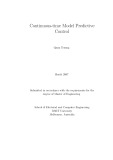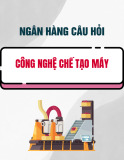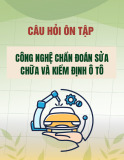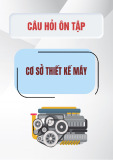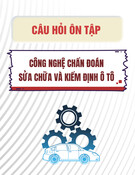
P-ISSN 1859-3585 E-ISSN 2615-9619 https://jst-haui.vn SCIENCE - TECHNOLOGY
Vol. 61 - No. 1 (Jan 2025) HaUI Journal of Science and Technology 95
MODELING AND SIMULATING THE DYNAMICS
OF AN ADAPTIVE THROTTLE SYSTEM ON AN AUTOMOBILE
MÔ HÌNH HÓA VÀ MÔ PHỎNG ĐỘNG LỰC HỌC HỆ THỐNG GA THÍCH ỨNG TRÊN Ô TÔ
Nguyen Xuan Tuan1,*, Luong Ngoc Huyen1
DOI: http://doi.org/10.57001/huih5804.2025.014
ABSTRACT
Currently, with the rapid development of science and technology, research
and application of information technology, electronics, and automation in
various automotive features, such as warning systems and automatic distance-
keeping with vehicles in front, automatic throttle control, have become essential
for enhancing safety and convenience for drivers. This article discusses an
adaptive cruise control system aimed at monitoring the dist
ance with the vehicle
ahead. This system allows for the automatic control of the throttle by electronic
control signals instead of manual pedal operation. In the research, a predictive
control model (MPC) is utilized within the Matlab/Simulink software to
simulate
the control process of the research model.
Keywords:
automotive dynamics, distance control, adaptive throttle
control, predictive control, Matlab/Simulink software, vehicle speed control,
automatic throttle system modeling.
TÓM TẮT
Hiện nay với sự phát triển mạnh mẽ về khoa học kỹ thuật, việc nghiên cứ
u,
ứng dụng công nghệ thông tin, điện tử, tự động hóa lên một số
tính năng như
cảnh báo, hỗ trợ giữ khoảng cách với xe phía trước, điều khiển ga tự độ
ng trang
bị trên các xe ô tô để tăng tính an toàn, tiện nghi cho lái xe là yêu cầu cấ
p bách.
Bài báo đề cập đến hệ thống ga thích ứng nhằm kiểm soát khoảng cách vớ
i xe
ô tô chạy phía trước, hệ thống cho phép điều khiển tự động bướm ga củ
a xe
bằng tín hiệu điều khiển điện tử thay vì người lái tác động vào bàn đạ
p ga.
Trong nghiên cứu sử dụng mô hình điều khiển dự đoán –
MPC (Model
Predictive Control) trong phần mềm Matlab/Simulink để mô phỏ
ng quá trình
điều khiển của mô hình nghiên cứu.
Từ khóa: Động lực học ô tô, kiểm soát khoảng cách, điều khiển ga thích ứ
ng,
điều khiển dự đoán, phần mềm Matlab/Simulink, kiểm soát vận tố
c ô tô, mô hình
hóa hệ thống ga tự động.
1
School of Mechanical and Automotive Engineering, Hanoi University of Industry,
Vietnam
*Email: tuannx@haui.edu.vn
Received: 06/5/2024
Revised: 29/8/2024
Accepted: 26/01/2025
1. INTRODUCTION
Figure 1. Diagram of the Adaptive Throttle System Operation
Currently, with the strong development of science and
technology, the research and application of information
technology, electronics and automation on car safety
systems such as: Electronic Throttle Control (ETC) allows
automatic control of the vehicle's throttle by electronic
control signals instead of the driver acting on the pedal
railway station; The Traction Control System (TCS) uses
sensors to monitor traction status and adjusts the throttle
and brake system to prevent wheels from sliding;
Electronic Stability Control (ESC) reduces the risk of
derailment and loss of control by automatically
intervening on the brakes and throttle to maintain vehicle
stability in dangerous situations (such as slipping or
tipping); Adaptive Cruise Control allows the driver to set a
sustained speed on a highway or highway; Collision
Warning System Using sensors and radar, this system can
detect potential incidents and warn drivers through audio
or visual to help drivers react in time; Lane Keeping Assist
monitors the vehicle's position in the lane and provides
warning or intervention to keep the vehicle in the middle
of the lane, preventing misdirection; The Distance Warning






